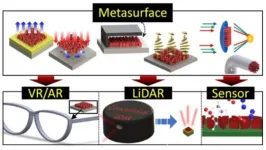(Press-News.org)
A new study has found that 12% of Americans are responsible for eating half of all beef consumed on a given day, a finding that may help consumer groups and government agencies craft educational messaging around the negative health and environmental impacts of beef consumption.
Those 12% – most likely to be men or people between the ages of 50 and 65 – eat what researchers called a disproportionate amount of beef on a given day, a distinction based on the latest Dietary Guidelines for Americans, which suggest 4 ounces per day of meat, poultry, and eggs combined for those consuming 2200 calories per day.
The study, published in the journal Nutrients, analyzed data from the CDC’s National Health and Nutrition Examination Survey, which tracked the meals of more than 10,000 adults over a 24-hour period. The global food system emits 17 billion tons of greenhouse gases a year, equivalent to a third of all planet-warming gases produced by human activity. The beef industry contributes heavily to that, producing 8-10 times more emissions than chicken, and over 50 times more than beans.
“We focused on beef because of its impact on the environment, and because it’s high in saturated fat, which is not good for your health,” said the study’s corresponding and senior author Diego Rose, professor and nutrition program director at Tulane University School of Public Health and Tropical Medicine.
Rose said the study's purpose was to assist in targeting educational programs or awareness campaigns to those eating disproportionate amounts of beef. Honing messaging around the environmental impact of beef production is crucial at a time when climate change awareness is higher than ever.
Rose said he and fellow researchers were “surprised” that a small percentage of people are responsible for such an outsized consumption of beef, but it’s yet to be determined if the findings are encouraging for sustainability advocates.
“On one hand, if it’s only 12% accounting for half the beef consumption, you could make some big gains if you get those 12% on board,” Rose said. “On the other hand, those 12% may be most resistant to change.”
The study also found that those who were not disproportionate beef consumers were more likely to have looked up USDA’s MyPlate food guidance system.
"This might indicate that exposure to dietary guidelines can be an effective tool in changing eating behaviors, but it could also be true that those who were aware of healthy or sustainable eating practices were also more likely to be aware of dietary guideline tools,” said Amelia Willits-Smith, lead author on the paper and a post-doctoral fellow at the University of North Carolina at Chapel Hill.
Of the beef consumed on a given day, almost a third came from cuts of beef such as steak or brisket. But six of the top 10 sources were mixed dishes such as burgers, burritos, tacos, meatloaf or spaghetti with meat sauce. Some of these foods may offer an easy opportunity for disproportionate beef eaters to alter their dietary habits.
“If you’re getting a burrito, you could just as easily ask for chicken instead of beef,” Willits-Smith said.
Those below the age of 29 and above the age of 66 were least likely to eat large amounts of beef. Rose said this indicated that the younger generation might be more interested in mitigating the effects of climate change.
“There's hope in the younger generation, because it's their planet they're going to inherit,” Rose said. “I’ve seen in my classes that they’re interested in diet, how it impacts the environment, and what can they do about it.”
In addition to Rose and Willits-Smith, the study's authors include Tulane clinical assistant professor Dr. Keelia O’Malley and Tulane Masters of Public Health graduate Harmonii Odinga.
END
Living in a racially segregated neighborhood puts Black children at a higher risk of having elevated blood lead levels, and this association has persisted over more than two decades, according to new research from the Children’s Environmental Health Initiative, which is led by University of Illinois Chicago Chancellor Marie Lynn Miranda.
The study, published in Pediatrics, analyzed data from the early 1990s and from 2015 from blood lead level tests of more than 320,000 children younger than 7 in North Carolina. Researchers ...
PULLMAN, Wash. – Grandparents appeared to serve as an important private safety net when COVID-19 first hit the U.S., according to a study led by a Washington State University researcher.
The pandemic’s arrival in 2020 coincided with a surge of nearly 510,000 children living in “doubled-up” households, co-residing with other adults in addition to their parents or parents’ partners. While these living arrangements had already been increasing before COVID-19, this was an additional increase beyond what would be expected based on previous trends ...
Research Highlights:
A study of more than 83,000 questionnaires by women ages 50-79, found more than 25% developed irregular heart rhythms, known as atrial fibrillation, which may increase their risk for stroke and heart failure.
Stressful life events and insomnia were strongly linked to the development of atrial fibrillation, highlighting the need for mental well-being evaluations to be included with physical health examinations.
Embargoed until 4 a.m. CT/5 a.m. ET Wednesday, Aug. 30, 2023
DALLAS, Aug. 30, 2023 — After menopause an estimated 1 in 4 women may develop irregular heart rhythms — known as atrial fibrillation – ...
Statement highlights:
This statement emphasizes that policies for patient data sharing should be interpreted and applied respectfully toward patients and research participants, equitable in impact both in terms of risks and potential benefits, and beneficial across broad and demographically diverse communities in the United States.
The statement outlines six new principles focused on encouraging the generalizability of research advances, good stewardship across the translational spectrum, transparency, education and involvement of patients, access and privacy protections.
Embargoed until 4:00 ...
Fresh discoveries about a type of immune cells could give lung cancer patients a more accurate prognosis and better identify who will benefit from immunotherapies.
Researchers found that the location in and around tumours of cytotoxic T cells, which play a key role in fighting cancer, may help predict patient survival and indicate whether or not treatments will work.
The findings could help to pave the way for improved immunotherapies - powerful but expensive life-extending treatments which currently fail in 80 per cent of cases - allowing them to work more effectively in more patients, researchers say.
Experts ...
"The unprecedented societal interruptions during the Covid-19 pandemic of 2020 and onward took their toll on economic activity. Lockdowns disrupted supply chains and caused economic losses with implications for private households," lead author Robin Middelanis from PIK explains. "Global stress like this reduces the economic capacity to cope with additional shocks from weather extremes that put even more pressure on already stressed societies.” For an individual climate disaster, impacts from local production losses can be flexibly reduced to a certain extent by the support ...
Bottom Line: Engaging in administrative tasks to estimate costs or pay for care among a cohort of cancer patients and survivors was associated with an 18% increase in cost-related treatment delays or nonadherence.
Journal in Which the Study was Published: Cancer Epidemiology, Biomarkers & Prevention, a journal of the American Association for Cancer Research (AACR)
Author: Meredith Doherty, PhD, LCSW, an assistant professor at the University of Pennsylvania School of Social Policy & Practice (SP2)
Background: Navigating the U.S. health care system ...
PISCATAWAY, NJ — It’s “liquid courage,” not necessarily “beer goggles”: New research indicates that consuming alcohol makes you more likely to approach people you already find attractive but does not make others appear more attractive, according to a report in the Journal of Studies on Alcohol and Drugs.
The conventional wisdom of alcohol’s effects is that intoxication makes others seem better looking. But, according to the new study, this phenomenon has not been studied systematically. Earlier research typically ...
Results from a study just released by Columbia University Mailman School of Public Health show major inequities in the location of lead service lines across New York City. Communities with large numbers of Hispanic/Latino residents and those with children who are already highly vulnerable to lead exposure from numerous sources are disproportionately impacted by water service lines that may contain lead. The study findings are published online in the journal Environmental Health Perspectives.
There is no safe level of lead exposure for children. Even at lower levels of exposure, lead is associated with impaired cognitive function, attention-related behavioral problems, and diminished academic ...
Metasurfaces, also known as invisibility cloak technology, are an artificial material adept at manipulating. With metasurfaces allowing for lenses to be reduced to one 10,000th the size of conventional lenses, they are generating considerable interest as optical components allowing miniaturization of optical systems for the next generation of virtual and augmented reality as well as LiDAR. If metasurfaces become commercially viable, overcoming the challenges of complex manufacturing processes and high production costs, Korea could gain a significant technological edge ...

